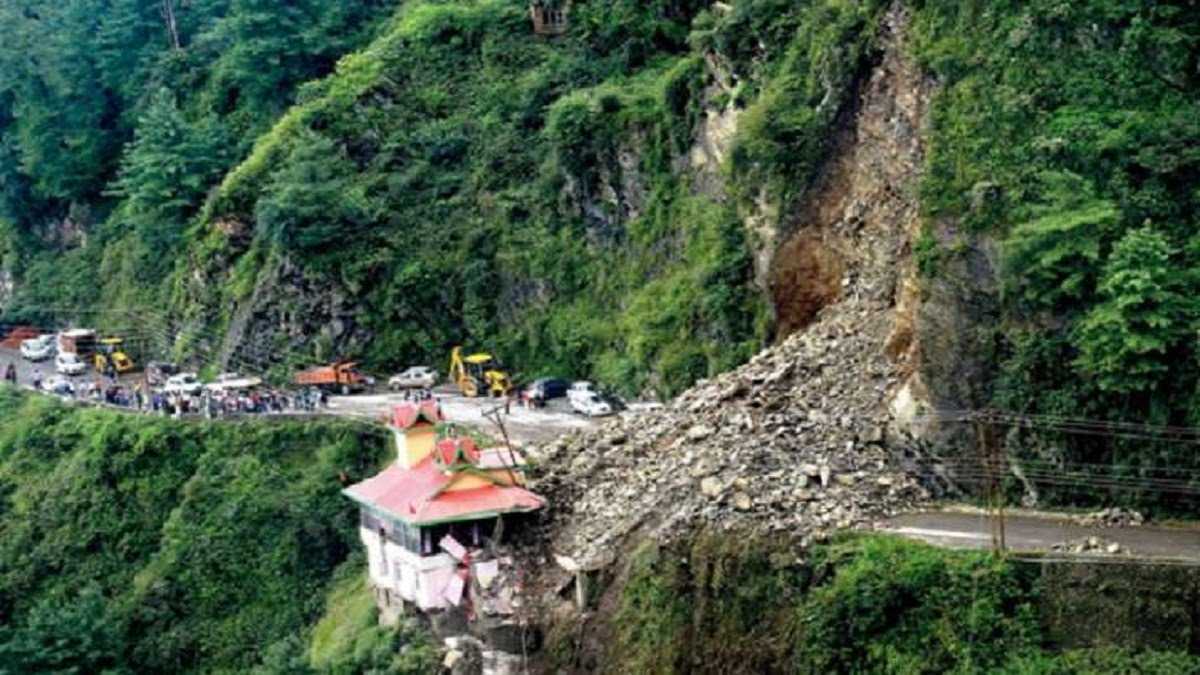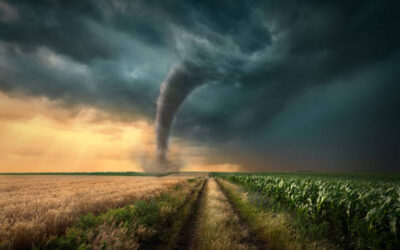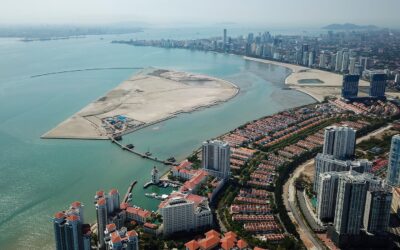Landslides are one of the most destructive natural hazards that frequently occur in mountainous regions, causing loss of life, property, and environmental degradation. A landslide is defined as the movement of a mass of rock, debris, or earth down a slope under the influence of gravity.
In India, the two most landslide-prone regions are the Himalayan mountain belt in the north and the Western Ghats in the south-west. While both regions experience frequent landslides, the underlying causes, geological settings, and triggering mechanisms differ significantly due to their unique physiographic, climatic, and anthropogenic factors.
This essay comprehensively examines and differentiates the causes of landslides in the Himalayan region and the Western Ghats, exploring natural and human-induced factors, and provides a comparative analysis supported by scientific studies and case examples.
Section I: Understanding Landslides
Definition and Types
A landslide is the downward and outward movement of slope-forming materials composed of rocks, soils, artificial fills, or a combination of these. Landslides are classified based on the type of movement (fall, slide, flow, topple, spread) and the material involved (rock, debris, earth).
Impacts of Landslides
Landslides can:
- Trigger secondary disasters (e.g., dammed river bursts)
- Destroy infrastructure (roads, railways, buildings)
- Cause fatalities and injuries
- Block rivers, leading to floods
- Disrupt communication and transport
Section II: Causes of Landslides in the Himalayan Region
The Himalayan region is globally recognized as one of the most landslide-prone areas due to its unique geological, tectonic, climatic, and anthropogenic characteristics.
A. Geological and Tectonic Factors
- Young Fold Mountains and Tectonic Instability
- The Himalayas are geologically young, fragile fold mountains, formed by the ongoing collision of the Indian and Eurasian plates.
- Active tectonic movements (e.g., thrusts, faults, earthquakes) constantly disturb the slope equilibrium, making the region inherently unstable.
- Major tectonic boundaries such as the Main Central Thrust (MCT), Main Boundary Thrust (MBT), and Himalayan Frontal Thrust (HFT) are zones of weakness where landslides are frequent.
- Steep Slopes and High Relief
- The Himalayas have steep, rugged slopes and deep valleys, increasing the gravitational force acting on slope materials and making them susceptible to failure.
- Weak and Weathered Rock Formations
- The region is characterized by highly weathered, fractured, and jointed rocks.
- Secondary discontinuities (faults, joints, bedding planes) reduce the strength of slope materials, facilitating landslides.
B. Climatic Factors
- Heavy Monsoonal Rainfall
- The Himalayas receive intense monsoonal rainfall, especially during June–September, which saturates the soil and rock, reducing cohesion and increasing pore-water pressure.
- Flash floods caused by sudden cloudbursts or glacial lake outbursts further destabilize slopes.
- Snowmelt and Glacial Activity
- Melting glaciers and snow during summer add to the water load, lubricating the base of slopes and increasing landslide risk, especially in higher altitudes.
- Glacial lake outburst floods (GLOFs) are increasingly frequent due to climate change.
- Seismic Activity
- Frequent earthquakes (e.g., Nepal earthquake 2015) weaken slope materials, causing co-seismic landslides.
- Earthquakes can trigger massive landslides by shaking loose already unstable slopes.
C. Geomorphological and Hydrological Factors
- River Erosion
- Active river systems (e.g., Ganga, Yamuna, Brahmaputra and their tributaries) erode the base of slopes, undercutting and destabilizing them.
- Rapid Weathering
- Physical and chemical weathering due to temperature fluctuations, freeze-thaw cycles, and high rainfall weaken the surface rocks and soils.
D. Anthropogenic (Human-Induced) Factors
- Deforestation
- Large-scale removal of forests for agriculture, urbanization, and infrastructure reduces root binding, exposing slopes to erosion and failure.
- Forests act as natural anchors; their removal increases landslide susceptibility.
- Unplanned Infrastructure Development
- Road construction, tunneling, and building activities often disregard geological assessments, leading to slope disturbances and increased landslide risk.
- Example: The Char Dham road project and rapid urbanization in Uttarakhand have led to increased landslide incidents.
- Mining and Quarrying
- Unregulated mining and quarrying destabilize slopes by removing support and causing vibrations.
- Unsustainable Tourism
- High tourist inflow leads to construction booms, waste generation, and increased pressure on fragile slopes (e.g., Kedarnath, Joshimath subsidence).
- Agricultural Practices
- Shifting cultivation (jhum), terracing, and irrigation can disturb natural drainage and slope stability.
E. Climate Change
- Rising temperatures increasing the rate of weathering and slope instability
- Increased frequency of extreme weather events (intense rainfall, cloudbursts)
- Accelerated glacial melt and changes in snow/rain patterns
Section III: Causes of Landslides in the Western Ghats
The Western Ghats, running parallel to India’s western coast, are also prone to landslides, but the causes differ due to their distinct geology, climate, and human activities.
A. Geological and Geomorphological Factors
- Old, Stable, but Weathered Rocks
- Unlike the Himalayas, the Western Ghats are ancient, geologically stable mountains formed mainly of hard basaltic rocks (Deccan Traps), charnockites, and gneisses.
- However, prolonged weathering has produced thick layers of laterite and soil, which can become unstable when saturated.
- Plateau Margins and Steep Escarpments
- The Ghats feature steep escarpments and plateau edges, which are susceptible to mass movements, especially where the overburden is thick.
B. Climatic Factors
- Intense Monsoonal Rainfall
- The Western Ghats receive very high rainfall (up to 7000 mm annually) during the Southwest monsoon.
- Prolonged and intense rainfall leads to over-saturation of the soil and triggers landslides, especially during June–September.
- Cyclonic Events
- The eastern slopes occasionally experience heavy rainfall due to cyclonic storms, which can also trigger landslides.
C. Hydrological and Soil Factors
- Overburden Saturation
- Landslides are mostly confined to the overburden (soil and weathered material) rather than the underlying bedrock.
- Waterlogging and blocked natural drainage due to human modifications increase the risk.
- Soil Properties
- Lateritic soils, common in the Ghats, are prone to slumping when saturated.
D. Anthropogenic Factors
- Deforestation and Land Use Changes
- Clearing of forests for plantations (tea, coffee, rubber), agriculture, and settlements reduces slope stability.
- Cultivation of seasonal crops and increase in settlements have led to withdrawal of toe support, making slopes vulnerable.
- Improper Agricultural Practices
- Heavy tilling, terracing, and contour bounding can disturb the natural structure of slopes, especially if not scientifically managed.
- Settlement Patterns
- Expansion of villages and towns on vulnerable slopes increases the risk of landslides.
- Blockage or Modification of Natural Drainage
- Construction of roads, buildings, and terracing often blocks or alters natural drainage lines, leading to water accumulation and slope failure during heavy rains.
E. Neo-Tectonic Activity
While the Western Ghats are geologically stable, there is evidence of neo-tectonic activity(recent movements), but its role in triggering landslides is less significant compared to the Himalayas
Section IV: Comparative Analysis of Causes
1. Geological Differences
- The Himalayan region is made up of young, tectonically active fold mountains, while the Western Ghats are ancient, geologically stable mountains.
- Himalayan rocks are mostly weak, weathered, and fractured sedimentary and metamorphic rocks, whereas the Western Ghats are composed mainly of hard basalt, laterite, gneiss, and charnockite.
- Tectonic activity is very high in the Himalayas, with frequent earthquakes, thrusts, and faults, but is low in the Western Ghats, where only minor neo-tectonic activity is seen.
- Slopes in the Himalayas are very steep with high relief, while the Western Ghats have steep escarpments and plateau margins, but generally less vertical relief than the Himalayas.
2. Climatic and Hydrological Differences
- The Himalayas experience heavy monsoon rainfall, snowmelt, and glacial melt, while the Western Ghats receive prolonged, heavy monsoon rainfall and occasional cyclonic events.
- Rainfall in the Himalayas is often intense and of short duration, sometimes causing cloudbursts, whereas the Western Ghats experience continuous, high annual rainfall during the monsoon.
- Hydrological triggers in the Himalayas include flash floods, glacial lake outburst floods (GLOFs), and river undercutting, but in the Western Ghats, over-saturation of soil and waterlogging due to blocked drainage are the main triggers.
3. Anthropogenic Differences
- Deforestation in the Himalayas is mainly for agriculture, road construction, and urbanization, while in the Western Ghats it is for plantations, agriculture, and expanding settlements.
- Infrastructure development in the Himalayas includes roads, tunnels, mining, and unplanned urban growth, whereas in the Western Ghats it is mostly roads, settlements, and improper agricultural expansion.
- Modification of natural drainage is common in both regions, but in the Himalayas it is often due to urban encroachment and blocked drainage, while in the Western Ghats it is due to terracing, roads, and construction that block or alter drainage lines.
- Tourism pressure is higher in the Himalayas due to pilgrimage and adventure tourism, while the Western Ghats face moderate pressure, mainly from eco-tourism and plantation-related activities.
4. Triggering Mechanisms
Anthropogenic activities such as deforestation, land use change, and blocked drainage are increasingly important triggers in both regions, but the specific forms and impacts differ.
- Earthquakes are a major trigger for landslides in the Himalayas, but are rare and less significant in the Western Ghats.
- Heavy rainfall is a major trigger in both regions, especially during the monsoon season.
- Glacial melting and related phenomena like GLOFs are significant triggers in the Himalayas, but do not occur in the Western Ghats.
Section V: Case Studies and Examples
A. Himalayan Region
- 2013 Uttarakhand Disaster: Intense rainfall and cloudbursts triggered massive landslides and flash floods, destroying infrastructure and claiming thousands of lives.
- 2015 Nepal Earthquake: Triggered hundreds of landslides, blocking rivers and causing further destruction.
- Joshimath Land Subsidence (2023): Unplanned construction, blocked drainage, and population pressure led to widespread land sinking and landslides.
- Kinnaur Landslide (2018): Glacial meltwater and heavy rainfall triggered a major landslide, blocking highways.
B. Western Ghats
- Kerala Landslides (2018, 2019, 2020): Prolonged monsoon rains led to catastrophic landslides in Wayanad, Idukki, and other districts, often confined to the overburden and exacerbated by deforestation and blocked drainage.
- Malin Landslide, Maharashtra (2014): Heavy rainfall and improper land use (agriculture on steep slopes) caused the collapse of an entire village.
- Nilgiris Landslides: Frequent landslides during monsoon, often linked to tea plantation practices and settlement expansion.
Causes of Landslides
Section VI: Mitigation and Management Strategies
A. Himalayan Region
- Comprehensive geological surveys before construction
- Afforestation and slope stabilization
- Proper drainage management
- Regulation of tourism and urban expansion
- Seismic-resistant infrastructure
- Early warning systems for rainfall and earthquakes
B. Western Ghats
- Scientific land use planning
- Afforestation and maintaining natural vegetation
- Regulation of agriculture and plantation practices
- Proper drainage and water management
- Restricting settlements on vulnerable slopes
- Community awareness and disaster preparedness
The causes of landslides in the Himalayan region and the Western Ghats are fundamentally different due to their unique geological, climatic, and human-induced factors.
The Himalayas, being young, tectonically active, and structurally weak, are prone to landslides triggered by earthquakes, intense rainfall, and glacial melt, further aggravated by unplanned development and deforestation.
In contrast, the Western Ghats, though geologically stable and ancient, are susceptible to landslides mainly due to prolonged monsoonal rainfall, over-saturation of weathered overburden, deforestation, improper land use, and blocked drainage.
Understanding these differences is crucial for developing region-specific mitigation and management strategies. Sustainable development, scientific planning, and community participation are essential to reduce the risk and impact of landslides in both regions, ensuring the safety of people, infrastructure, and the environment.





0 Comments